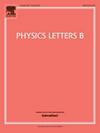旋转光学虫洞时空中的框架拖拽和光偏转
IF 4.5
2区 物理与天体物理
Q1 ASTRONOMY & ASTROPHYSICS
引用次数: 0
摘要
在这项工作中,我们详细分析了具有恒定负高斯曲率的旋转光学虫洞时空族中的零测地线,包括双曲,椭圆和贝尔特拉米几何。通过显式推导出完整的零测地线方程,我们描述了这些弯曲旋转背景中的光子轨迹。我们的分析强调了旋转在形成光路中的作用,显示了框架拖拽效应、遍历区域出现(尽管没有事件视界)和因果结构的变化如何影响光子动力学。我们构造了控制径向光子运动的有效势的精确形式,允许对轨道稳定性和临界轨迹进行系统的研究。获得了重力偏转角的封闭表达式,以及这些几何形状特有的光学视界存在和定位的明确条件。我们的研究结果表明,旋转效应和几何特定的径向形状函数之间的相互作用至关重要地决定了光在这些奇异时空中的行为。虽然有些特征与模拟重力模型相呼应,但我们的框架仍然严格遵循广义相对论。该研究为理解具有非平凡拓扑的时空中的引力透镜和视界行为提供了严格的基础。本文章由计算机程序翻译,如有差异,请以英文原文为准。
Frame-dragging and light deflection in rotating optical wormhole spacetimes
In this work, we present a detailed analytical study of null geodesics in a family of rotating optical wormhole spacetimes with constant negative Gaussian curvature, encompassing hyperbolic, elliptic, and Beltrami geometries. By explicitly deriving the full set of null geodesic equations, we characterize photon trajectories in these curved, rotating backgrounds. Our analysis highlights the role of rotation in shaping light paths, showing how frame-dragging effects, ergoregion emergence (despite the absence of event horizons), and alterations in causal structure influence photon dynamics. We construct exact forms of the effective potential governing radial photon motion, allowing for a systematic investigation of orbit stability and critical trajectories. Closed-form expressions for gravitational deflection angles are obtained, along with clear conditions for the presence and positioning of optical horizons unique to these geometries. Our findings demonstrate that the interplay between rotational effects and the geometry-specific radial shape functions crucially determines how light behaves in these exotic spacetimes. While some features echo those of analog gravity models, our framework remains strictly within general relativity. This study provides a rigorous foundation for understanding gravitational lensing and horizon behavior in spacetimes with nontrivial topology.
求助全文
通过发布文献求助,成功后即可免费获取论文全文。
去求助
来源期刊

Physics Letters B
物理-物理:综合
CiteScore
9.10
自引率
6.80%
发文量
647
审稿时长
3 months
期刊介绍:
Physics Letters B ensures the rapid publication of important new results in particle physics, nuclear physics and cosmology. Specialized editors are responsible for contributions in experimental nuclear physics, theoretical nuclear physics, experimental high-energy physics, theoretical high-energy physics, and astrophysics.
 求助内容:
求助内容: 应助结果提醒方式:
应助结果提醒方式:


